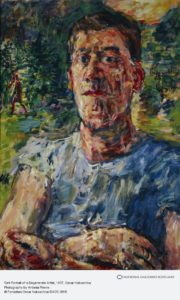
They came by the thousands, the men in suits, the women in ankle-length dresses and brimmed hats. They peered somberly at wild primitivist paintings and twisted, expressionist sculptures. They read wall text that said “This is how sick minds viewed nature,” “An insult to German womanhood,” and “Madness becomes method.” Some, perhaps feeling the need for an antidote to the diseased art, walked across the park to see an exhibit of heroic Aryan realism.
The scene was Munich, the year 1937. The first exhibit, called Entartete Kunst” or “Degenerate Art,” ridiculed such artists as Max Beckman, Oskar Kokoschka and George Grosz– all revered today. The other show, the “Great German Art Exhibition,” was curated by a failed realist artist named Adolf Hitler and offered a slew of academic painters who are mostly forgotten today.
Now, Neue Galerie, the Manhattan museum devoted to Austrian and German expressionism, has mounted a show that documents this Nazi war on modernist art. The Nazis hated many things, but this particular one grew out of theories that compared expressionism and surrealism to the art of the mentally ill. Such art, the Nazis insisted, undermined the sanity of the culture and had to be banned and eradicated.
One of the earliest targets was the famed Bauhaus school of design, whose form-follows-function “International Style,” was said to be overly influenced by Jews and communists. The school was forced to move twice before being closed by the Nazis in 1933.
Hitler’s men also had reason to dislike Bauhaus teacher Paul Klee for his childlike, stick-figure compositions such as “The Twittering Machine,” on view here. Klee was hounded until he fled for his former Swiss home. Some 17 of his pieces were seized for the “Degenerate Art” Exhibit.

Klee was more fortunate than the great expressionist painter Ernst Ludwig Kirchner, a founder of Die Brucke (The Bridge), a style from Dresden that aimed to bridge modernism and the art of the past. They revived the great German tradition of woodcuts, expressionist versions of which can be seen here. None of this earned him any points with the Nazis. Kirchner’s group portrait of Die Brucke captures their strange position in Nazi Germany – they are serious, professorial-looking artists, but painted in a dark purplish palette that conveys something of their subterranean status.
Kirchner’s life was destroyed by the Nazis. He was forced to resign from teaching in 1933, saw most of his paintings destroyed, and killed himself in exile in 1938.
Kokoschka, who was Austrian, seemingly had the healthiest response to be branded as degenerate. In the roughly painted “Self-Portrait as a Degenerate Artist,” he looks strong and resolute, much less tormented than the way he usually rendered himself.
The gallery dedicated to the infamous 1937 Munich exhibit is presented as a duel of sorts, with “degenerate” works on one side and pieces of comparable motifs from the “Great German Art Exhibition” on the other. On the expressionist side is Beckman’s famous triptych, “Departure,” with its images of dismemberment and torture flanking a panel showing a king on a sea voyage – an apparent allusion to Beckman’s flight from Nazi Germany (he found refuge in America). Its respectable opponent is another triptych, Adolf Ziegler’s “The Four Elements,” with four comely blonde nudes as allegorical figures representing earth, air, fire and water. The work hung above Hitler’s mantelpiece.
One gallery’s array of empty frames recalls all the confiscated works that are still lost. These labeled frames were discovered in an abandoned mind, their canvases cut out. Also in this gallery is ledger showing the disposition of some 16,000 works confiscated from German museums and collections. The book is open to a page showing two Max Beckmann works that were sold to the art dealer Hildebrand Gurlitt, one of four dealers authorized to sell confiscated art to foreign buyers. In 2012, German authorities seized a cache of art from the Munich apartment of his son, Cornelius Gurlitt, who had kept the hoard all these years.

Many other works are still unaccounted for today. Prior to the “Degenerate Art” exhibit, the Nazis seized 5,000 works from some 32 German museums, including 1,052 by Nolde, 759 by Heckel, 639 by Ernst Ludwig Kirchner and 508 by Max Beckmann. Some 650 works made it into the infamous 1937 exhibit. Other works were sold into private collections. When buyers didn’t materialize, the Nazis sometimes made bonfires of the art in order to stimulate demand.
One interesting fact about the “Degenerate Art” exhibit is that it attracted many more people than the show of sanctioned art. An incredible 2 million people came through between July and November of that year. Only 500,000 went to see the “Great German Art Exhibition.”

